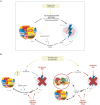Diet quality and anxiety: a critical overview with focus on the gut microbiome
- PMID: 38812941
- PMCID: PMC11133642
- DOI: 10.3389/fnut.2024.1346483
Diet quality and anxiety: a critical overview with focus on the gut microbiome
Abstract
Anxiety disorders disproportionally affect females and are frequently comorbid with eating disorders. With the emerging field of nutritional psychiatry, focus has been put on the impact of diet quality in anxiety pathophysiology and gut microbiome underlying mechanisms. While the relationship between diet and anxiety is bidirectional, improving dietary habits could better facilitate the actions of pharmacological and psychological therapies, or prevent their use. A better understanding of how gut bacteria mediate and moderate such relationship could further contribute to develop personalized programs and inform probiotics and prebiotics manufacturing. To date, studies that look simultaneously at diet, the gut microbiome, and anxiety are missing as only pairwise relationships among them have been investigated. Therefore, this study aims at summarizing and integrating the existing knowledge on the dietary effects on anxiety with focus on gut microbiome. Findings on the effects of diet on anxiety are critically summarized and reinterpreted in relation to findings on (i) the effects of diet on the gut microbiome composition, and (ii) the associations between the abundance of certain gut bacteria and anxiety. This novel interpretation suggests a theoretical model where the relationship between diet and anxiety is mediated and/or modulated by the gut microbiome through multiple mechanisms. In parallel, this study critically evaluates methodologies employed in the nutritional field to investigate the effects of diet on anxiety highlighting a lack of systematic operationalization and assessment strategies. Therefore, it ultimately proposes a novel evidence-based approach that can enhance studies validity, reliability, systematicity, and translation to clinical and community settings.
Keywords: anxiety; diet; diet quality; gut microbiome; sex stratification.
Copyright © 2024 Basso, Zorzan, Johnstone, Barberis and Cohen Kadosh.
Conflict of interest statement
The authors declare that the research was conducted in the absence of any commercial or financial relationships that could be construed as a potential conflict of interest. The author(s) declared that they were an editorial board member of Frontiers, at the time of submission. This had no impact on the peer review process and the final decision.
Figures





Similar articles
-
The Brain, the Eating Plate, and the Gut Microbiome: Partners in Migraine Pathogenesis.Nutrients. 2024 Jul 11;16(14):2222. doi: 10.3390/nu16142222. Nutrients. 2024. PMID: 39064664 Free PMC article. Review.
-
Evaluating the interactive effects of dietary habits and human gut microbiome on the risks of depression and anxiety.Psychol Med. 2023 May;53(7):3047-3055. doi: 10.1017/S0033291721005092. Epub 2022 Jan 25. Psychol Med. 2023. PMID: 35074039
-
The influence of gut microbiome on bone health and related dietary strategies against bone dysfunctions.Food Res Int. 2021 Jun;144:110331. doi: 10.1016/j.foodres.2021.110331. Epub 2021 Mar 22. Food Res Int. 2021. PMID: 34053534 Review.
-
Associations between Diet, the Gut Microbiome, and Short-Chain Fatty Acid Production among Older Caribbean Latino Adults.J Acad Nutr Diet. 2020 Dec;120(12):2047-2060.e6. doi: 10.1016/j.jand.2020.04.018. Epub 2020 Aug 12. J Acad Nutr Diet. 2020. PMID: 32798072
-
Significance of the Gut Microbiome for Viral Diarrheal and Extra-Intestinal Diseases.Viruses. 2021 Aug 12;13(8):1601. doi: 10.3390/v13081601. Viruses. 2021. PMID: 34452466 Free PMC article. Review.
References
-
- Santomauro DF, Herrera AMM, Shadid J, Zheng P, Ashbaugh C, Pigott DM, et al. . Global prevalence and burden of depressive and anxiety disorders in 204 countries and territories in 2020 due to the COVID-19 pandemic. Lancet. (2021) 398:1700–12. doi: 10.1016/S0140-6736(21)02143-7, PMID: - DOI - PMC - PubMed
-
- Naidoo U. (2020). The food mood connection. Hachette, UK.
Grants and funding
LinkOut - more resources
Full Text Sources

